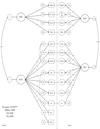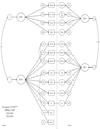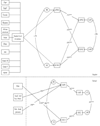Co-occurrences between adolescent substance use and academic performance: school context influences a multilevel-longitudinal perspective
- PMID: 25057764
- PMCID: PMC4142206
- DOI: 10.1016/j.adolescence.2014.06.006
Co-occurrences between adolescent substance use and academic performance: school context influences a multilevel-longitudinal perspective
Abstract
A growing body of literature has linked substance use and academic performance exploring substance use as a predictor of academic performance or vice versa. This study uses a different approach conceptualizing substance use and academic performance as parallel outcomes and exploring two topics: its multilevel-longitudinal association and school contextual effects on both outcomes. Using multilevel Confirmatory Factor Analysis and multilevel-longitudinal analyses, the empirical estimates relied on 7843 students nested in 114 schools (Add Health study). The main finding suggests that the correlation between substance use and academic performance was positive at the school level in contraposition to the negative relationship at the individual level. Additional findings suggest a positive effect of a school risk factor on substance use and a positive effect of academic pressure on academic performance. These findings represent a contribution to our understanding of how schools could affect the relationship between academic performance and substance use.
Keywords: Academic performance; Adolescents; Co-occurrences; Multilevel longitudinal; School context; Substance use.
Copyright © 2014 The Foundation for Professionals in Services for Adolescents. Published by Elsevier Ltd. All rights reserved.
Figures




Similar articles
-
Recovery schools for improving behavioral and academic outcomes among students in recovery from substance use disorders: a systematic review.Campbell Syst Rev. 2018 Oct 4;14(1):1-86. doi: 10.4073/csr.2018.9. eCollection 2018. Campbell Syst Rev. 2018. PMID: 37131375 Free PMC article.
-
Measuring psychosocial environments using individual responses: an application of multilevel factor analysis to examining students in schools.Prev Sci. 2015 Jul;16(5):718-33. doi: 10.1007/s11121-014-0523-x. Prev Sci. 2015. PMID: 25421872 Free PMC article.
-
Multilevel modeling of direct effects and interactions of peers, parents, school, and community influences on adolescent substance use.J Youth Adolesc. 2009 Sep;38(8):1038-49. doi: 10.1007/s10964-009-9425-9. Epub 2009 Jun 12. J Youth Adolesc. 2009. PMID: 19636769
-
Is there a "school effect" on pupil outcomes? A review of multilevel studies.J Epidemiol Community Health. 2006 Feb;60(2):149-55. doi: 10.1136/jech.2005.036707. J Epidemiol Community Health. 2006. PMID: 16415266 Free PMC article. Review.
-
The Relationship between School Absenteeism and Substance Use: An Integrative Literature Review.Subst Use Misuse. 2020;55(3):491-502. doi: 10.1080/10826084.2019.1686021. Epub 2019 Dec 5. Subst Use Misuse. 2020. PMID: 31805820 Review.
Cited by
-
The Relationship between Multiple Substance Use, Perceived Academic Achievements, and Selected Socio-Demographic Factors in a Polish Adolescent Sample.Int J Environ Res Public Health. 2016 Dec 21;13(12):1264. doi: 10.3390/ijerph13121264. Int J Environ Res Public Health. 2016. PMID: 28009806 Free PMC article.
-
How Urban Youth Perceive Relationships Among School Environments, Social Networks, Self-Concept, and Substance Use.Acad Pediatr. 2017 Mar;17(2):161-167. doi: 10.1016/j.acap.2016.10.007. Acad Pediatr. 2017. PMID: 28259338 Free PMC article.
-
"Just as expensive as sending him to college:" barriers and perceptions of treatment in justice-involved youth.Health Justice. 2024 Jul 23;12(1):33. doi: 10.1186/s40352-024-00289-2. Health Justice. 2024. PMID: 39042254 Free PMC article.
-
Psychosocial Problems Syndemically Increase Adolescent Substance Use: Findings From a Cross-sectional Survey of 82,812 Chinese Adolescents.Medicine (Baltimore). 2015 Dec;94(52):e2393. doi: 10.1097/MD.0000000000002393. Medicine (Baltimore). 2015. PMID: 26717391 Free PMC article.
-
Substances use and its association with socio-demographic, family, and environment-related factors among technical and vocational education and training college students in Ataye, Ethiopia; an institution-based cross-sectional study.BMC Public Health. 2020 Nov 11;20(1):1691. doi: 10.1186/s12889-020-09797-w. BMC Public Health. 2020. PMID: 33176773 Free PMC article.
References
-
- Bachman JG, O’Malley PM, Schulenberg JE, Johnston LD, Freedman-Doan P, Messersmith EE. The education-drug use connection: how successes and failures in school relate to adolescent smoking, drinking, drug use, and delinquency. New York: L. Erlbaum Associates; 2008.
-
- Bollen KA, Curran PJ. Wiley Series in Probability and Statistics. Hoboken: New Jersey: Wiley & Sons, INC.; 2006. Latent Curve Models.
-
- Bronfenbrenner U. The Ecology of Human Development: Experiments by nature and design. Cambridge, MA: Harvard University Press; 1979.
-
- Bronfenbrenner U. Making human beings human. Bioecological perspective on human development. Thousand Oaks, CA: Sage Publications; 2005.
Publication types
MeSH terms
Grants and funding
LinkOut - more resources
Full Text Sources
Other Literature Sources
Medical

